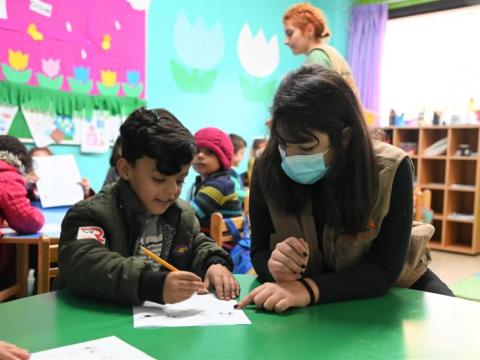N4G: There's not a moment to waste
Colleen says that the world knows how to stop wasting among children, we just need the political and financial commitment to make it happen.
By Colleen Emary, Senior Technical Advisor, Nutrition
The professor stood silently at the front of the classroom snapping his fingers at 3 second intervals. The chatter among classmates quickly died down, as we all sat in silent wonder at what this was all about. “Every 3 seconds” he said, “Every 3 seconds a child dies of malnutrition.” That statistic stayed with me long after that course, and that lecture was one of the pivotal moments that led to a career in international nutrition.
Sadly, in the 20 years since that university lecture, the plight of the world’s malnourished children remains as dire as ever, particularly for children suffering from wasting. Wasting, also known as acute malnutrition, is when a child is too thin for their height and is caused by a lack of nutritious diet and/or illness due to infectious disease. In 2021, 45 million children suffer wasting, and this is expected to increase by as much as 13.6 million children due to the COVID-19 pandemic. Children with the most severe form of wasting are nearly 12 times more likely to die than children who are well nourished. Sadly, progress toward the World Health Organization target of reducing wasting to less than 5% by 2025 remains stagnant.
This lack of progress isn’t the result of not knowing what do to. We know what to do. What we require is the political and financial commitment to make it happen.
Firstly, we need to scale up interventions to prevent wasting, by ensuring pregnant women, mothers and young children have access to essential health, nutrition and social services, and that they can practice positive feeding and caring behaviours.
Secondly, we need to increase efforts to detect wasting, so that children with wasting can be identified earlier, before their case of wasting becomes more serious and difficult to treat. And lastly, we need to make life-saving treatment available to all children who require it, wherever they live. Currently, less than one third of children with wasting have access to treatment.
This is an exciting time. Maintaining the status quo is not acceptable and as a result there are renewed efforts to address wasting. In my nearly 20 years of working on wasting, I don’t remember a time where there has been this level of interest and collaborative work among global and national partners.
Recently, World Vision joined with other global nutrition actors to develop a “Call to Action” to catalyse action and accountability on the prevention, detection and treatment of wasting. Collectively, by acting upon the six priority actions, we can provide life-saving treatment for children with wasting, and prevent millions more from becoming wasted.
Last week, I attended a side event on wasting in the lead up to the Nutrition for Growth (N4G) Summit. Governments of Cambodia, Pakistan, the Philippines, Mali, Timor Leste, Burkina Faso, Mali and the Democratic Republic of the Congo presented ambitious country roadmaps to address wasting, work undertaken as part of the UN-led Global Action Plan on Wasting. While it is encouraging to see these concrete plans to tackle wasting at the country level, their implementation depends on sustained political commitment and significant financial investment.
As the world’s attention turns to the N4G Summit in Tokyo, where a cross-section of stakeholders will announce final financial and policy commitments, and chart the path toward 2030 with concrete recommendations to the global community. I hope governments are listening. The world’s wasted children cannot wait.
Colleen is Senior Technical Advisor, Nutrition for the Technical Services Organisation at World Vision. She is a public health nutritionist, with 20 years of experience working on global nutrition issues. She has provided leadership for design, implementation and evaluation of nutrition programmes, including short-term and remote technical support for several countries in Africa, Asia and Latin America, along with emergency deployments to Bangladesh, Chad, and Democratic Republic of the Congo. She is an active contributor to the global emergency nutrition community, as a member of the Global Nutrition Cluster (GNC) Strategic Advisory Group and of the GNC Technical Alliance Leadership team. Follower her on Twitter @Cremary
